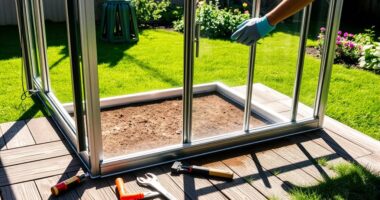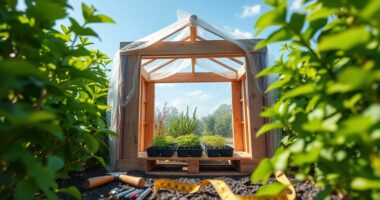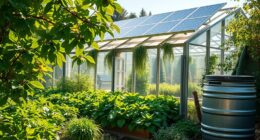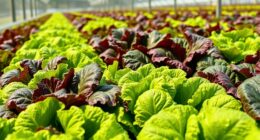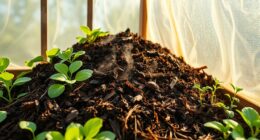To waterproof your greenhouse, start by selecting the right sealant for your panels—polycarbonate needs metal tape, while glass requires silicone caulk. Insulate with UV-resistant plastic to keep temperatures steady, and lay a damp-proof membrane under the floor to prevent moisture rise. Install effective gutters that slope for proper water drainage and consider erosion control strategies around your greenhouse. With these steps in place, you’ll create a secure environment for your plants to thrive. Discover more essential tips ahead!
Key Takeaways
- Select the appropriate sealant based on panel material, using silicone caulking for glass and metal tape for polycarbonate.
- Ensure all edges are tightly sealed with UV-resistant plastic films to prevent heat loss and moisture entry.
- Install a heavy gauge polythene damp proof membrane beneath the floor slab to block moisture rise.
- Regularly inspect and maintain gutters, ensuring they are sloped for efficient water flow and drainage.
- Apply protective coatings to metal components to prevent rust and ensure long-term durability.
Selecting the Right Sealant for Your Greenhouse Panels
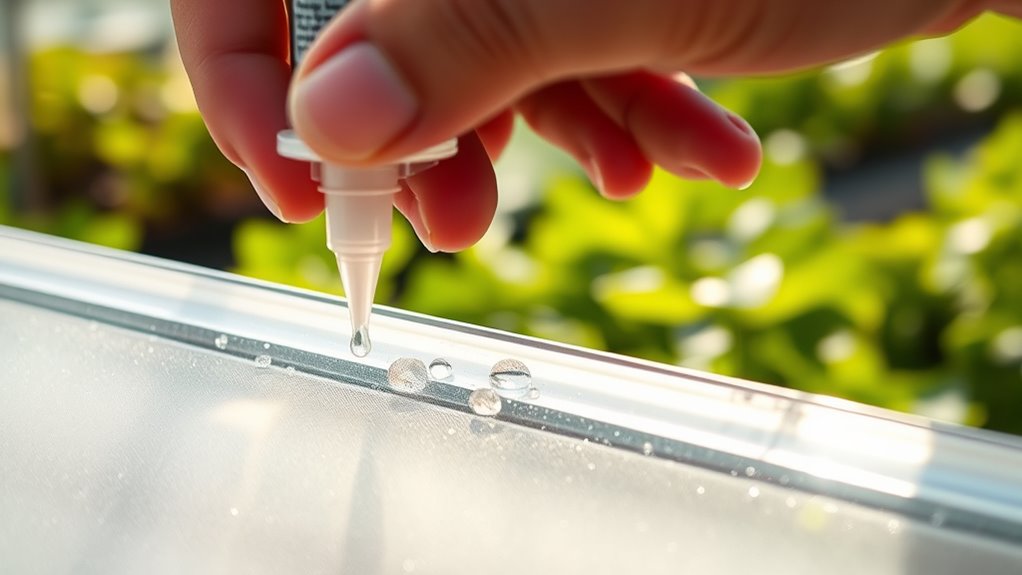
How do you choose the best sealant for your greenhouse panels?
First, assess your panel material. Polycarbonate panels need metal tape or edge sealing tape, while glass greenhouses typically require silicone caulking for gaps.
Assess your panel material: polycarbonate needs metal tape, while glass requires silicone caulking for effective sealing.
If you have aluminum frames, opt for durable aluminum tape, and for wooden frames, elastomeric caulk works well due to its flexibility.
Multi-wall panels benefit from U-profile edging to seal flutes effectively.
Remember to consider UV stability for outdoor durability and ease of application, as some sealants can go over old seals.
Lastly, match the sealant to your frame type and estimate the seal length needed to avoid waste.
Choosing wisely ensures your greenhouse remains watertight and efficient.
Insulating With UV Plastic for Enhanced Temperature Control

When you insulate your greenhouse with UV plastic, you’re not just adding a protective layer; you’re enhancing temperature control for your plants.
UV-resistant plastic films, like polyethylene and polycarbonate, offer excellent durability against harsh weather while allowing optimal light penetration crucial for photosynthesis.
These materials retain heat, creating a stable environment, especially during colder months. Plus, they’re cost-effective and simpler to install than traditional glass.
Ensure tight seals around edges to prevent heat loss, and consider lining the interior for even better heat retention.
With proper installation, your greenhouse will maintain a consistent temperature, promote healthier plants, and extend your growing season, making it a smart investment for any gardener.
Preparing the Greenhouse Floor for Waterproofing

Preparing the floor of your greenhouse is essential for effective waterproofing, as it sets the foundation for a moisture-resistant environment.
Start by laying a heavy gauge polythene damp proof membrane beneath your floor slab to prevent moisture from rising. Concrete is a popular choice for durability, but ensure it’s properly cured by covering it with wet hessian or polythene.
Laying a heavy gauge polythene damp proof membrane is crucial for preventing moisture rise beneath your greenhouse floor slab.
You can also add gravel or sand on top of the membrane for better drainage and slip resistance. If you already have a concrete floor, consider sealing it with concrete sealing paint.
Regularly inspect the floor for any damage, and maintain proper drainage by ensuring a slight slope for water runoff. This preparation is key to a long-lasting, waterproof greenhouse.
Installing Effective Gutter Systems for Water Management
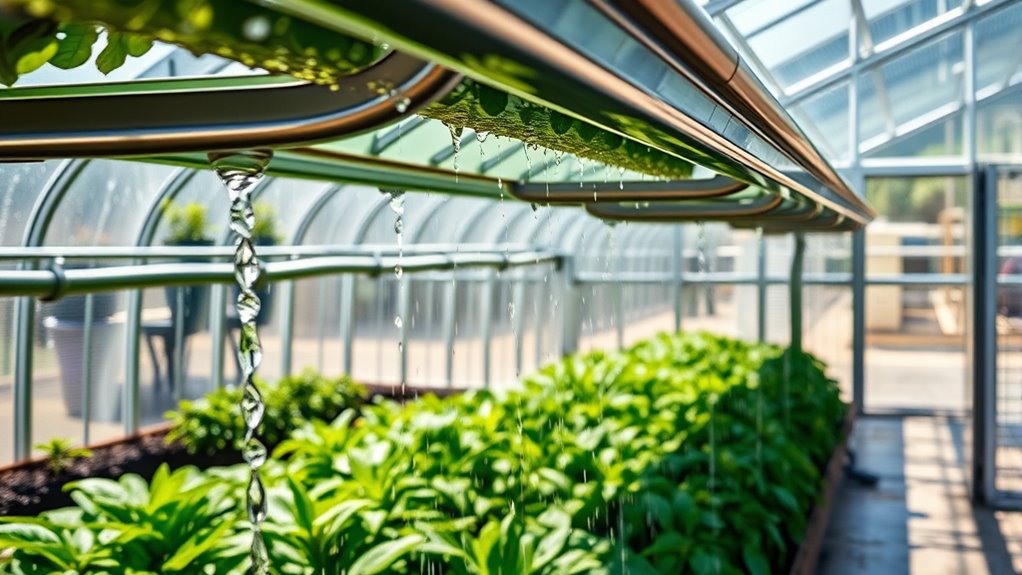
To effectively manage water in your greenhouse, installing a well-designed gutter system is crucial. Start by choosing durable metal coils that can be customized on-site using portable gutter machines.
Ensure the gutters are slightly sloped to promote efficient water flow toward downspouts. Connect these downspouts to larger pipes, ranging from 4 to 18 inches in diameter, maintaining a minimum slope of 1/16th inch per foot to prevent stagnation.
Regularly inspect and clean gutters and pipes to maintain efficiency, ideally every 100 feet. Additionally, consider incorporating rainwater harvesting features for irrigation. A well-installed gutter system not only manages water effectively but also promotes sustainability and can lead to cost savings in the long run. Furthermore, implementing rainwater harvesting systems can significantly enhance your greenhouse’s water management capabilities.
Strategies to Prevent Water Erosion Around Your Greenhouse
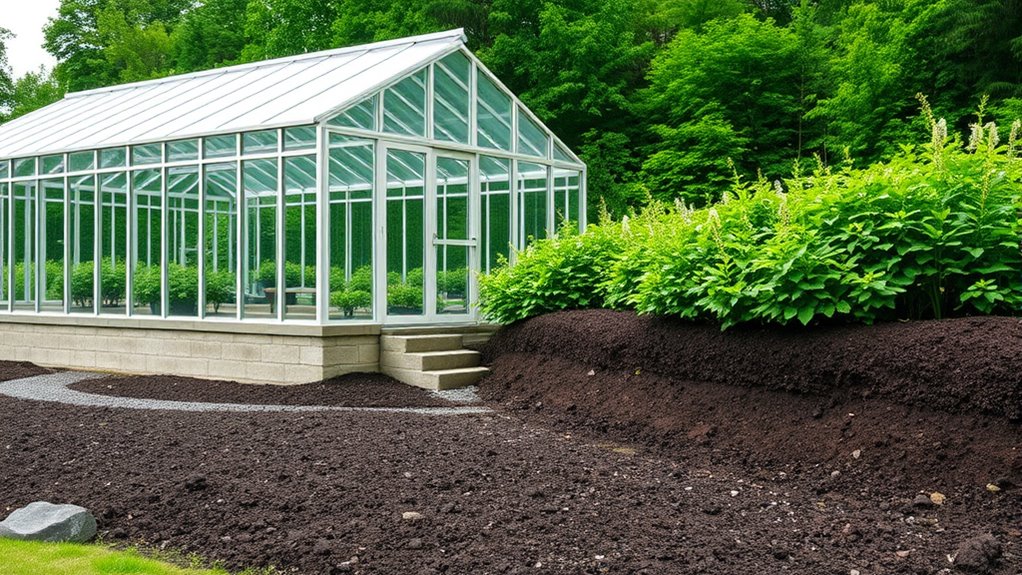
While managing water erosion around your greenhouse is essential for maintaining a healthy environment, implementing effective strategies can significantly reduce soil loss.
Start by planting fast-growing vegetation, like grass, to stabilize the soil quickly. Mulch areas lacking cover with wood chips or straw to protect against erosion. Additionally, using high-quality equipment for landscaping can enhance the effectiveness of your erosion control methods.
Planting fast-growing vegetation and using mulch are effective ways to quickly stabilize soil and prevent erosion.
Consider terracing or contouring your landscape to slow water flow and enhance absorption. You can also use erosion control wattles or riprap to divert water effectively.
Incorporate ground cover plants and native species to strengthen the soil’s structure. Additionally, creating a rain garden will maximize water absorption, reducing runoff. This approach not only protects your greenhouse but also aligns with the principles of community resilience emphasized in emergency preparedness.
Maintaining Proper Humidity Levels With Sealing Techniques

Properly managing water erosion around your greenhouse sets the stage for maintaining optimal humidity levels, which is vital for plant health.
To achieve this, use effective sealing materials like metal tape or edge sealing tape for your greenhouse panels. Keep humidity between 40% and 80% for healthy plant growth.
Different materials require specific sealants; for instance, UV-stable foam tape works well for glass, while metal tape is best for polycarbonate. Regularly inspect seals to ensure they’re intact, helping retain warmth and humidity.
Consider adding misting systems or humidifiers to boost moisture levels, especially in dry weather.
Finally, monitor humidity with hygrometers to make adjustments as needed, ensuring a thriving environment for your plants.
Ensuring Optimal Air Circulation in a Sealed Greenhouse

Ensuring optimal air circulation in a sealed greenhouse is essential for creating a healthy environment for your plants. Proper ventilation maintains CO2 levels and prevents humidity buildup that can lead to mold and pests.
Use adjustable vents and fans to manage temperature and ensure air circulation. Aim for at least two complete air changes per hour for a thriving atmosphere.
Incorporate natural ventilation by designing your greenhouse to harness wind, which can provide up to 80% of your needs. Consider automated controls that open vents based on temperature, enhancing efficiency.
Balancing airtightness with ventilation is key to retaining heat without overheating or increasing humidity, ensuring your plants remain vigorous and healthy.
Cost-Effective Methods for Waterproofing Your Greenhouse
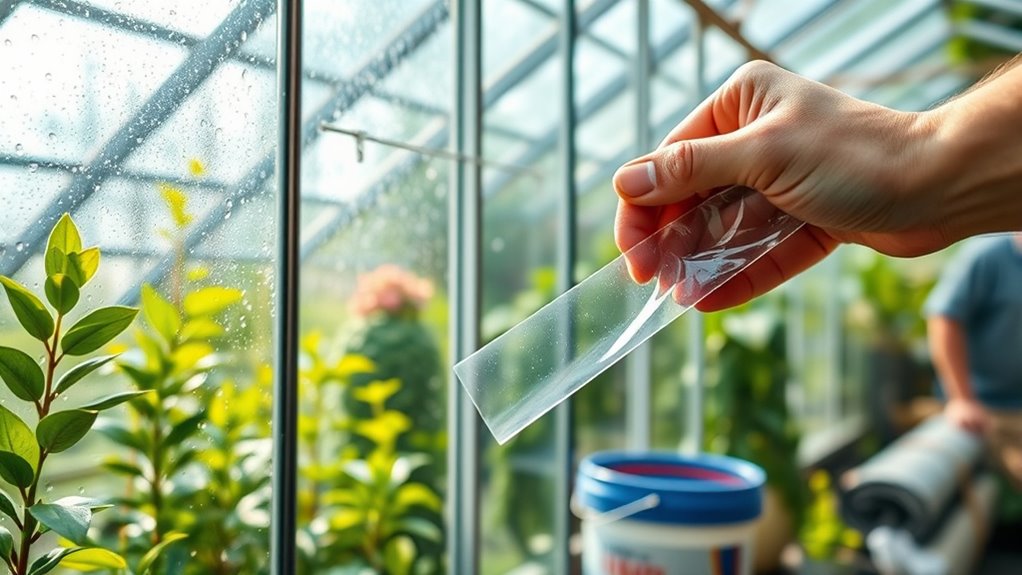
Maintaining good air circulation is just one part of creating a thriving greenhouse environment; waterproofing is equally important for protecting your plants and structure.
To save on costs, consider using clear tarps or polyethylene sheeting as affordable alternatives to glass. These materials not only provide waterproof protection but also resist UV damage. Dual-flush toilets are an example of how innovative designs can maximize efficiency, much like how these materials can maximize plant growth by keeping moisture in. Regular maintenance of waterproofing treatments can further enhance the longevity of your greenhouse materials. Additionally, using eucalyptus oil can help create a healthier environment by acting as a natural pest deterrent. Incorporating solar panels can also help power additional equipment for optimal plant growth.
PVC membranes are another budget-friendly option, while string-reinforced tarps offer added strength. For installation, employ simple lapping techniques or peel-and-stick methods for easy application.
Secure your materials with grommets to ensure stability. Plus, breathable membranes like Tyvek help manage humidity, promoting plant health. Additionally, incorporating omega-3 sources like chia seeds into your gardening routine can enhance plant vitality and resilience.
Regular Maintenance to Preserve Waterproofing Integrity
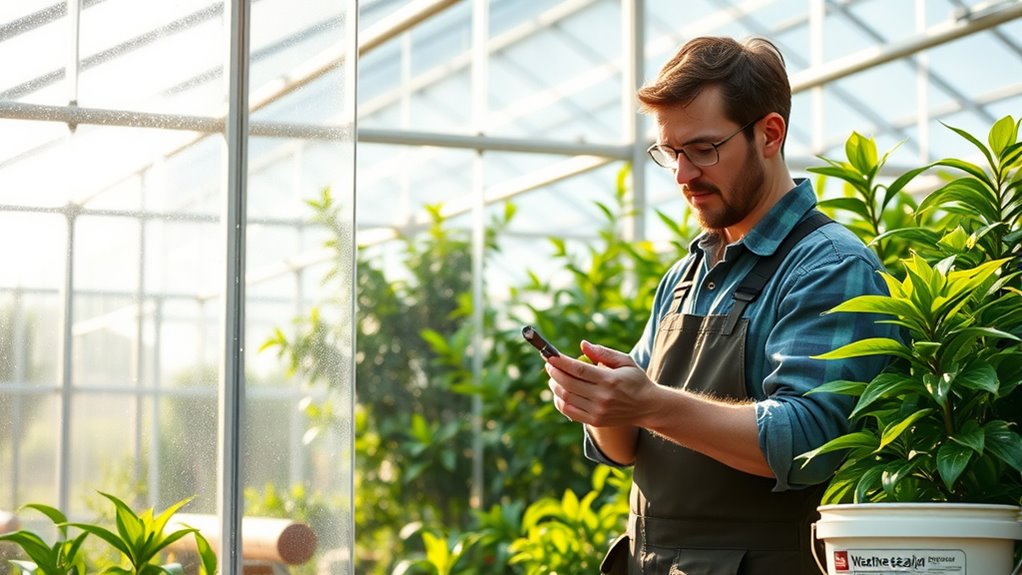
To keep your greenhouse waterproof and your plants thriving, regular maintenance is essential. Start by inspecting glazing materials for cracks and ensuring structural integrity.
Clean gutters regularly to prevent blockages, and check downspouts to keep drainage lines clear. After extreme weather, examine for any immediate damage.
Maintain your frame by promptly repairing or replacing damaged parts, and apply protective coatings to prevent rust.
Clear the perimeter of weeds and debris, and scrub the exterior to remove dirt.
Don’t forget to maintain your ventilation system by cleaning filters and lubricating moving parts.
Keeping a log of all maintenance activities helps track your efforts and ensures your greenhouse remains a safe haven for your plants.
Frequently Asked Questions
How Often Should I Inspect My Greenhouse for Leaks?
You should inspect your greenhouse for leaks at least seasonally, checking for signs of damage or wear.
After severe weather, give it a thorough look to ensure everything’s intact.
Annual inspections are crucial for addressing hidden issues, while pre-storm checks help secure the structure against extreme conditions.
Keep an eye out throughout the year for any noticeable water spots or drafts, so your plants stay healthy and thriving.
Can I Use Recycled Materials for Waterproofing?
Imagine building a sturdy raft from old bottles; that’s how recycled materials can waterproof your greenhouse. Yes, you can definitely use them!
Materials like recycled fabrics or old windows not only keep water out but also promote sustainability. By sealing seams with epoxy or using Gorilla waterproof tape, you ensure durability.
Plus, it’s budget-friendly! So, gather those recyclables, and start creating a functional, eco-friendly space for your plants to thrive.
What Are the Signs of Water Damage in a Greenhouse?
You’ll notice several signs of water damage in your greenhouse.
Look for discoloration or stains on walls and ceilings, and check for peeling paint or wallpaper.
Mold growth often appears as black or green spots.
You might detect musty smells or feel soft, spongy textures in the walls.
On the roof, watch for leaks and stains, while the floor may have standing water, discoloration, or slippery surfaces indicating moisture issues.
How Do I Choose the Right Waterproofing for My Climate?
Choosing the right waterproofing for your climate’s like picking a raincoat for a stormy day.
You wouldn’t wear a light jacket in a downpour, right? First, consider your area’s rainfall, temperature extremes, and humidity levels.
Look for materials with fewer seams and strong adhesion. Ensure they can withstand local weather patterns.
Finally, factor in local building codes to ensure your choice meets essential standards for durability and effectiveness.
Are There Specific Plants That Require Higher Humidity Levels?
Yes, there are specific plants that thrive in higher humidity levels.
For instance, Boston ferns and Calathea plants need humidity above 60% to flourish.
Marble pothos and orchids prefer a range of 40-70% for optimal growth.
Majesty palms also thrive around 50% humidity.
If you’re looking to create a lush environment, these plants can enhance your space while benefiting from the moisture they love.
Just ensure you monitor the humidity regularly!
Conclusion
By taking these targeted steps, you can create a cozy, climate-controlled greenhouse that withstands the whims of weather. With the right sealants, smart insulation, and savvy water management, your plants will thrive in a dry, delightful environment. Remember, regular maintenance is key to keeping your greenhouse’s waterproofing powerful. So, roll up your sleeves and embrace the art of effective enclosure—your garden’s growth will thank you for it!



